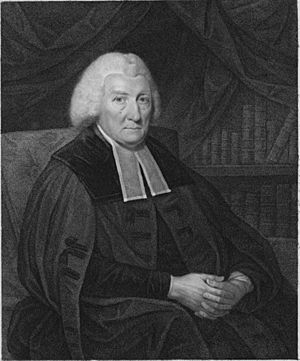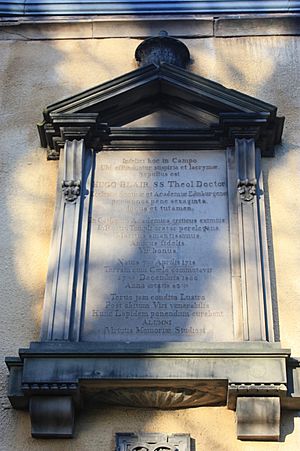Hugh Blair facts for kids
Quick facts for kids
Hugh Blair
FRSE
|
|
|---|---|
 |
|
| Born | 7 April 1718 |
| Died | 27 December 1800 (aged 82) |
| Nationality | Scottish |
| Occupation | theologian, author, rhetorician |
|
Notable work
|
Sermons (1777–1801) |
Hugh Blair (born April 7, 1718 – died December 27, 1800) was an important Scottish minister, writer, and expert in public speaking. He is known as one of the first major thinkers about how we write and communicate.
Blair was a minister in the Church of Scotland. He also held a special teaching position at the University of Edinburgh. This position was called the Chair of Rhetoric and Belles Lettres. His ideas greatly influenced both religious and everyday life. He is most famous for his book series Sermons, which taught about Christian morals. He also wrote Lectures on Rhetoric and Belles Lettres, a guide on how to write well. Blair was a key figure in the Scottish Enlightenment, a time of great learning and new ideas in Scotland.
Contents
Hugh Blair's Early Life and Education
Blair was born in Edinburgh, Scotland. His family was educated and followed the Presbyterian faith. His father, John Blair, was a merchant in Edinburgh. From a young age, it was clear that Hugh, who was often sick, would become a church leader.
He went to the High School. Later, he studied moral philosophy and literature at the University of Edinburgh. He earned his Master of Arts degree when he was 21. His university paper discussed the basics of morality and good behavior. This paper showed what he would later write about in his Sermons.
Becoming a Minister
In 1741, Hugh Blair became a licensed Presbyterian preacher. Soon after, a nobleman named the Earl of Leven heard about Blair's popularity. He offered Blair a job as a minister at the Parish Church of Collessie in Fife.
By 1743, Blair moved to the Canongate Kirk in Edinburgh. He became the second minister there. Later, in 1754, he became the main minister at Lady Yester's Kirk. In 1758, he moved to the famous High Kirk of St Giles. He was the second minister there, but it was still a very important position in Scotland. He stayed in this role for many years. During this time, he published his five-volume series of Sermons.
Teaching at the University
After his success in the church, Blair focused on education. In 1757, the University of St Andrews gave him an honorary degree. In 1759, he started teaching about Rhetoric and Belles Lettres at the University of Edinburgh. At first, students paid him directly. But his classes became so popular that the university created a permanent teaching spot.
In 1762, Blair became a Professor of Rhetoric and Belles Lettres. King George III approved this position. He taught until he retired in 1783. After retiring, Blair published many of his lessons in a book called Lectures on Rhetoric and Belles Lettres.
Later Life and Friends
In 1773, Blair lived in Argyle Square in Edinburgh's Old Town. This area was later torn down to build Chambers Street. In 1777, he became a chaplain for the 71st Regiment of Foot, a military group.
In 1783, Blair helped start the Royal Society of Edinburgh. This was a group for important thinkers and scientists. He was its Literary President from 1789 to 1796.
Blair had a very busy life, both publicly and privately. He was a key person in the Scottish Enlightenment. He was friends with many other famous scholars of the time. These included David Hume, Adam Smith, and Adam Ferguson. He also had a summer home in the village of Restalrig.
Hugh Blair passed away at his home in Argyle Square on December 27, 1800. He is buried in Greyfriars Churchyard in Edinburgh. A memorial was later put up for him there.
Hugh Blair's Family Life
Blair had a loving marriage to his cousin, Katherine Bannatine. They married in April 1748. Katherine's father was also a minister.
Hugh and Katherine had two children. Their son died at birth. Their daughter, Katherine, died at age 20 in 1769. Both of their children passed away before them. Blair also outlived his wife, who died in 1795. People described Blair as kind and helpful to young writers.
Hugh Blair's Important Works
Blair is best known for three main books: A Critical Dissertation on the Poems of Ossian, Son of Fingal; Sermons; and Lectures on Rhetoric and Belles Lettres. He also published other works without his name on them. One important anonymous work was an eight-volume collection of Shakespeare's plays that Blair edited.
About A Critical Dissertation on the Poems of Ossian
In 1763, Blair published A Critical Dissertation on the Poems of Ossian. This was his first well-known book published under his own name. Blair was very interested in the old Celtic poetry from the Scottish Highlands. He wrote a very positive review of the Ossian poems. He strongly believed they were real and very old. Blair had even encouraged his friend, James Macpherson, to publish these poems.
His book argued against people who said the poems were not ancient. These critics thought the poems were written by modern poets, or even by Macpherson himself. After 1765, Blair's book was included in every new printing of the Ossian poems. This was done to make the poems seem more believable. However, Blair's praise did not last. The poems were later found to be fake, and Macpherson was found guilty of literary forgery. While this work might not show Blair as a great literary critic, it does show his personal taste in writing.
About Sermons
In 1777, Blair published the first of his five-volume series called Sermons. These books were collections of his speeches as a Presbyterian preacher. They focused on practical Christian morals. Even though published religious teachings were becoming less popular, Sermons was a huge success.
Blair was considered the most popular preacher in Scotland. His success came from his clear and organized style. His sermons were easy for people to follow, both when he spoke and when they were printed.
Sermons showed Blair's moderate views. He was socially conservative in many ways. He did not believe in big, sudden changes. His teachings were safe and mostly for the upper classes. But he also had some liberal ideas. He did not agree with some strict Calvinist beliefs, like original sin.
The Sermons focused more on questions of morality than on deep religious ideas. They encouraged patriotism, being active in society, and living a good life. Blair told people to improve their natural talents through hard work. He also said they should be happy with their place in society. He urged people to enjoy life, do good deeds, and keep their faith in God.
Blair's ability to appeal to both feelings and logic made his Sermons very popular. Four editions were published while he was alive, and a fifth came out after his death. The books were translated into many European languages and printed many times. Although some later critics found them too simple, they were very important during Blair's time.
About Lectures on Rhetoric and Belles Lettres
After retiring from his teaching job in 1783, Blair published his lectures. He felt it was important to do this because unauthorized copies of his work were being passed around. The result was Lectures on Rhetoric and Belles Lettres. This book is seen as Blair's most important work.
Lectures is a collection of 47 lessons Blair gave to students at the University of Edinburgh. It is a practical guide for young people on how to write and use language well. This book made Blair one of the first great thinkers about written communication.
This book is important not because it had totally new ideas. Blair himself said it combined his understanding of classical and modern ideas about language. Lectures used ideas from famous thinkers like Quintilian and Cicero. It also included modern ideas from writers like Joseph Addison and Edmund Burke. It became one of the first complete guides to language. It was also one of the first books to focus on written communication, not just speaking. Blair's Lectures was a clear, helpful guide that brought together centuries of ideas.
The goal of Lectures was to give young people a simple guide to the value of good writing. Blair believed that being well-educated and using polite language was key to social success. For him, learning about literature helped people improve their social standing. It also encouraged good behavior and morals. Blair also believed that a person needed to be virtuous and have good character to be a good speaker or writer.
While his lectures taught how to write, they also focused on how to understand written literature. He gave examples from current literature to show good writing qualities. Students would then identify, analyze, and learn from these qualities. The idea was that students would develop good taste and appreciate beautiful language.
Blair's idea of "taste" involved two parts of the mind: a person's senses and their thinking process. By practicing the five senses, a person could improve their taste. By using their reasoning, a person could tell what was truly pleasing and what was not. When senses and reason worked together, a critic developed "taste-delicacy" and "correctness of taste." Taste delicacy meant stronger and more accurate senses. Correctness of taste meant being able to judge and value something, and to recognize what is truly good.
Blair's book covered many topics related to writing. His main ideas were about taste, language, style, and eloquence (public speaking). He also looked closely at different types of writing, both prose and verse.
Blair believed that the rules of good writing came from nature. His definition of taste showed this: "The power of receiving pleasure from the beauties of nature and art." His ideas about taste were very important. He thought taste was the foundation of good communication, both written and spoken.
While Blair's work often combined existing ideas, it had many valuable insights. His discussion of the history of written communication was important because this history had often been ignored. He also named and defined four types of writing: historical writing, philosophical writing, fictitious history, and poetry. He also analyzed different parts of communication. One of Blair's more new ideas was rejecting some old ideas about figures of speech. He argued that new ideas come from knowledge, not from special writing tricks.
Blair's Lectures on Rhetoric and Belles Lettres brought together important ideas about writing and literature. It was a clear and helpful guide for writing in the 18th century. It was very popular for almost 100 years. Over 130 editions were published in many European languages. It was a bestseller in Europe, especially in Italy, where it was known as Ugone Blair.
Hugh Blair's Influence
Blair wrote at a time when printed books were becoming very popular. Traditional public speaking was becoming less important. Blair focused on ideas of self-improvement and moving up in society. This fit well with the 18th-century belief that people could improve their lives. At this time, new wealth from factories and trade helped the middle class grow. Blair's idea that good communication could help people succeed fit perfectly with the times.
His Lectures on Rhetoric and Belles Lettres were used in many famous schools. They served as a guide for writing for many years. The Lectures were especially popular in the United States. Colleges like Yale and Harvard used Blair's ideas.
However, Blair's reputation later declined. When the Ossian poems were proven fake, his credibility suffered. His Sermons were criticized for being too emotional and not clear enough on religious beliefs. They did not adapt to changing tastes. The Lectures also lost popularity as new thinkers built on Blair's ideas.


